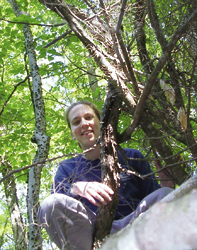Calcium in the Forest Ecosystem
WHEN CLAIRE HOFF was looking at graduate schools after finishing up at Cornell University she was steadfast.
“Basically, I wanted to do research I wanted to do – not something a professor had sitting on the sidelines,” says the Ph.D. student in the Natural Resources and Earth Systems Science interdisciplinary program.
After making the rounds at other potential graduate schools, Hoff found her seminal research project upon visiting UNH and meeting with professors Julie Bryce of the Department of Earth Sciences and Erik Hobbie of the Complex Systems Research Center and Department of Natural Resources and the Environment.
Claire Hoff |
For example, Hoff notes, sugar maples—so key to the character and economy of New England—are in decline and scientists suspect a lack of calcium might be the culprit.
But the cause-effect link is hard to show scientifically because, among other things, it’s unknown how tree roots, and the fungi that have a symbiotic relationship with them, actually take up calcium and make it available to the rest of the plant.
Moreover, while the ultimate source of calcium is bedrock, scientists don’t know how long it takes to replenish the soil pool after calcium ions get displaced from soil particles and are, ultimately, washed downstream.
One key aspect of her project is trying to determine if mycorrhizal (meaning “fungus root”) fungi have the ability to extract calcium directly from bedrock and give it to trees. If this is indeed occurring, it would mean that trees don’t have to wait for the time-consuming weathering process to make calcium available once again. (It is also unknown if tree roots themselves have the ability to get calcium directly from bedrock.)
The only means of deciphering these complex and circuitous microscopic processes is to use chemical “tracers” and follow them on their journey through the terrestrial ecosystem.
Hoff’s first step in her research was to show that the previously accepted tracer technique (using strontium) did not truthfully replicate calcium’s behavior throughout natural processes and that, instead, using different isotopes of calcium as a means of tracking calcium’s fate might solve the riddle.
Mirroring the path she took as an undergraduate, Hoff’s Ph.D. work is decidedly interdisciplinary. At Cornell, she took a degree in Science of Earth Systems, which involved course work out of three colleges and a variety of disciplines.
“I always knew I wanted to do interdisciplinary work,” she says. After getting a strong foundation in science and mathematics she concentrated her upper level coursework in ecology and courses that were oriented towards systems- and conceptual-thinking but also had a hard science component that is usually left out in more traditional subject divisions.
With funding from a National Science Foundation Critical Zone Exploration Network grant, this past summer Hoff conducted an experiment in Belgium under the guidance of professor Jan Colpaert, a noted expert on mycorrhizal fungi and a colleague of Hoff’s co-advisor Erik Hobbie. Central Europe has had severe problems with acid rain and soil calcium depletion in forest ecosystems.
Hoff grew seedlings of Scotch pine and sugar maple in syringes under carefully controlled conditions. She is now in the process of analyzing her samples using an EOS state-of-the-art mass spectrometer that will provide elemental concentrations and, thus, help map out the calcium cycle. The numbers from this little, closed-system experiment can then be extrapolated to a terrestrial ecosystem.
Another aspect of her doctoral work is investigating the role magnesium plays as it cycles through the terrestrial ecosystem. As calcium goes in forest soils so goes magnesium—downstream in the wake of acid rain. And, in some systems, magnesium could be the limiting nutrient, not calcium.
Explains Hoff, “Magnesium is, in fact, an essential component of chlorophyll, and I’ll be looking at whether it’s both calcium and magnesium together or separately that’s causing the problem of declining health in forest ecosystems.” (Acidic soils also end up releasing aluminum ions, which can damage root cells thereby compounding the problem of limited nutrients.)
She notes that a look back in the scientific literature shows calcium and magnesium were once considered partners in the puzzle, “but then magnesium disappeared from the equation for no apparent reason and everyone jumped on the calcium bandwagon.”
But the bandwagon of research has yet to provide good answers on just how calcium moves through the system to build healthy trees; Hoff hopes to solve the calcium-magnesium riddle.

